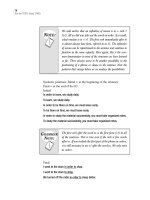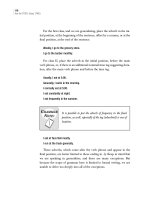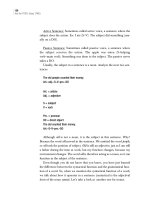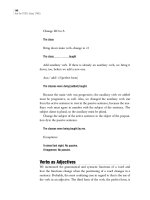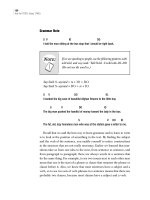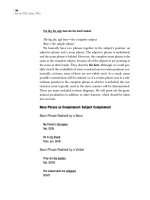Tài liệu Ace the toefl essay part 5 pptx
Bạn đang xem bản rút gọn của tài liệu. Xem và tải ngay bản đầy đủ của tài liệu tại đây (168.93 KB, 10 trang )
30
Ace the TOEFL Essay (TWE)
simple sentences. You must have a line of coherence, one that sets forth
clear steps on how to perform a procedure.
TR
¶ Conclusion
About three sentences
You may qualify that you included alternative ways to approach your
procedure.
Transitions
Transitions effectively control the reader by controlling the flow of an
argument. Transitions regulate the time during which a reader has an idea.
After completing a paragraph, look at the structure. You should be able to
see how much space you have given a particular subject. You should also
easily recognize where you have made mistakes in logic or coherence.
Specifically, if you have wavered on a particular subject, perhaps only
talked around a subject, this is obvious to see by looking at the transition-
al phrases. Even speed-reading specialists teach that one must learn to
focus on transitions, because they reflect a change in the structure of ideas.
Again, to use the analogy of a road map, transitions signal the reader
where he should go, and, if used effectively, control the reader’s attention
as well. Transitions can be single words, several-word phrases, clauses,
sentences, or paragraphs. I have taught around the world, and the most
common advice I give to students taking the TOEFL exam is to circle the
transitional phrases on the Reading Comprehension part of the test so that
they can easily follow the flow of the paragraph. Then, the transitions are
especially easy to find when answering the questions about the reading.
The same idea applies to writing. Learn the transitions, and your writing
will empower you to write your way to academic success. Memorize the
lists below.
Agreement: also, plus, in addition, further, furthermore, moreover,
additionally, to add to that, next, in accordance with, accordingly, in
agreement, finally, for instance, for example, in exemplification, exempli-
fying that, in point of fact, in fact, factually speaking, in terms of, and so
TOEFL Internals flowed 7/13/07 3:35 PM Page 30
31
Essay Formats
forth, looking at the nexus between, in coordination with, along those
lines, collectively speaking, generally speaking
Contrast: however, contrastingly, in contrast, on the other hand, to put
it into perspective, from a different angle, nonetheless, nevertheless, but,
yet, a catch to this is, sadly enough, as a hindrance, looking at the holdups,
oddly enough, instead, in direct opposition
Result: as a result, as a consequence, consequently, thus, therefore,
hence, thereby, resulting in, ultimately, in the end, finally, in the overall
analysis, in hindsight, in retrospect, retrospectively, vicariously, the long-
term effect, in hindsight, as a short-term result, significantly, as a major
effect, effectively, heretofore, hereafter, thereafter
Some of these straddle different categories. In one particu-
lar example, they may signify a different meaning compared
to another example in a different context.
Tip: If you always think of yourself as actually being in the paper, you
know instinctively where to point your reader. For example, if I talk about
the effect of something up until the present time, I may use the word
heretofore. From that point on, I could use the word hereafter. I am still talk-
ing about result, but I am pointing either backward or forward. Your
papers always deal with the relationship of a certain time to another. This
is imperative to remember for logical consistency. If you think of yourself
like this in your own paper, your reader will probably not get lost,
because he will have the road signs that tell him how he got there, where
he is, and where he will go in the paper from there. Those road signs are
the words, the transitions, which link. In addition, when a professor has
any doubt about the content of your paper, he can go back and reread by
simply following the transitions.
For now, let’s think of our transitions as attachments at the front,
middle, or end of our sentences. Our sentences are, in essence, radar
controlled, guided by the transition. Start with thinking of the transitions
THE
:
RE
NOTE:
TOEFL Internals flowed 7/13/07 3:35 PM Page 31
32
Ace the TOEFL Essay (TWE)
at the beginning of the sentence; then, add from there. If the sentence
doesn’t follow the radar device, the sentence will be illogical, filled with
static, and so will the logic of all of the sentences around it. They will
collide, because our guiding force was not in sync with the rest of the
unit. The following chapter deals with different pods most common in
academia. We’ll move through each paper carefully, methodically,
looking at the structure, keeping an eye on how things cohere, where
they fit together, and why. Remember: We add to and take away from
these structures. There are endless combinations possible using these
pods. For purposes of definition,
pod refers to the particular name we
give to the type of paper we write: for example, comparison-contrast,
description, cause-effect, and many more are types of papers, named
thus because of the pod employed. One of the main items we will keep
looking at again and again is the transition. So, instead of devoting a
chapter to it, we will refer to the transition when we change pods.
Now we have established a very basic foundation for the following
pods. After the chapter on punctuation, you have a whole list of essays
that are direct answers to sample TOEFL questions. Remember that you
have numerous combinations to use when writing these essays, including
a mix-and-match approach, which is mainly effective if you have a prob-
lem reaching the required length.
TOEFL Internals flowed 7/13/07 3:35 PM Page 32
The Comma
The comma is used to set off words, several-word phrases, or clauses.
There are two basic rules I like to use when determining when to put
a comma in a sentence.
The Formal Rule
If you have an independent clause (IC), and something comes to the left
of the subject, and it’s not an article, and it’s not an adjective, set it off with
a comma.
Example: On the way,[ we stopped at the store.]
S–V
IC
The big boy ate the candy.
Art.–adj.–S–V–art.–Direct Object (DO)
There is no comma in the second example, because it does not follow
the rule (the words before the subject are an article and an adjective). We
said that the clause must be an IC. That means it must be able to stand
alone. If not, it’s not an IC. If it’s not independent, it’s either a sentence
CHAPTER TWO:
Punctuation
TOEFL Internals flowed 7/13/07 3:35 PM Page 33
34
Ace the TOEFL Essay (TWE)
fragment or a dependent clause (DC). A DC will usually begin with a
word that will make it depend on a subsequent sentence to complete the
thought. For example:
When I was a boy, I ate candy.
DC–IC
The DC usually has a subject and a verb, and it is referred to as a sub-
ordinate clause. The subordinator makes an IC dependent. Generally, a
subordinator is usually a preposition:
in, on, after, under, whenever, before,
while, among, next, toward.
Not all DCs necessarily have a subject and a verb, but, for the sake of
discussion, we will talk in generalizations. Therefore, although a clause or
phrase that comes before an IC may not have both a subject and a verb,
we usually set it off by using both rules described here.
Along the banks, fires were glowing.
Around the bend, a truck had crashed.
In December, we stay in the house.
After dinner, we ate dessert.
Up the coast, there were many seagulls.
Under the table, the boy played carelessly.
The Gut Rule
Simply put, if there is no trauma, don’t add a comma.
I don’t want to oversimplify, but we can usually look at the sentence
and determine what is pertinent information and what is superfluous. By
doing this, combined with the formal rule, we can figure out where to put
the comma.
For example: Today, I went to the store. Yesterday, I went shopping.
The important information comes after the comma in both sentences.
It is not really important that the person went to the store today. Simply
the fact that he went to the store is important. The same logic is true with
TOEFL Internals flowed 7/13/07 3:35 PM Page 34
35
Punctuation
the second sentence. Now, if I want to make the information of today just
as important as the fact that I went to the store, I will integrate that into
the structure of the IC. For example: I went to the store today. I went
shopping yesterday. I want to eat chicken tonight.
Let’s view these sentences in regard to how they are actually spoken.
If the time tag is at the beginning of the sentence, there will be a slight
pause in the sentence before I start to say the information in the IC. This
pause is a change in tone that leads me to believe that I must include a
comma. Note that the tone goes down where the comma is inserted, and
it rises again after the comma in the IC.
Tone: ______________~
—
|
______________
Today, I went shopping.
I went shopping today.
Tone: ______________
Tone and stress are two different things. I can stress a certain word, but
that does not necessarily mean that I automatically put in a comma.
Likewise, I now feel compelled to dispel a myth. Most of us were taught—
and wrongly, I might add—to put a comma in a sentence if there is a
pause. Well, that’s not always true. Following that logic, let’s look at an
example. Let’s assume that my wife saw me at the store with a beautiful
woman, and she asked me about it after I made it home. Following the
logic of the rule we are usually taught in elementary school, we would
punctuate my reply with the commas indicated. Keep in mind that I will
choose my answer very carefully to her question, because I will definite-
ly live with my answer for the rest of my life.
Question: Who was that woman you were with at the store?
Answer: S,s,s,s,s,hh,he,ee ii,i,is,s,s,ss mm,mm,yy ff,f,ffr,rr,iiennd.
(She is my friend.)
I hope you get my point. So, let’s forget about the rule that we must
always put in a comma if there is a pause in a sentence. If there is no
trauma, don’t add a comma. We almost always need commas after
TOEFL Internals flowed 7/13/07 3:35 PM Page 35
36
Ace the TOEFL Essay (TWE)
transitional phrases, which we’ve discussed before, because they come
before an IC.
Afterthought
An afterthought needs to come after an IC. It signals extra information,
but at the end of a sentence. There may be contention with a professor
about the use of commas in this regard, because only you can determine
whether the afterthought is actually extra information or whether it is, in
fact, pertinent.
We sat down and ate candy, and old bread.
I saw the man with one arm,
and also his dog.
I ate the whole chicken,
then had dessert.
We played football,
and basketball.
However, a sentence with one subject and two predicates (verbs) or
two objects does not need a comma. Ex: He ran and walked. He ate bread
and cheese.
Appositive
An appositive commonly renames a noun, and it is usually set off by com-
mas. The noun and the other phrase renaming or describing it have ref-
erence in common, one normally renaming another. Some appositives are
not set off, and these are deemed restricted, because their address is
directed (restricted) to only the noun or its equivalent next to it. Again,
restricted means that one does not add any commas, because the descrip-
tion is restricted or limited to the word or phrase directly next to it.
Those set off with commas are nonrestricted.
The fat boy, the one with the glasses, sat on my ice cream.
I like sports, namely boxing
, more than studying.
Her most outstanding characteristic, being nice
, brought her luck.
One thing, running
, is better than most anything I know.
He bought her a gift for her birthday, a cruise
.
TOEFL Internals flowed 7/13/07 3:35 PM Page 36
37
Punctuation
The man Jon lit a smoke.
The general, Rommel
, won the battle.
The underlined words are the appositives. All the underlined phrases
rename or describe the noun before it, except in the fifth sentence, where
cruise renames gift. Here, a cruise is an afterthought, so we offset it with a
comma.
Interjections
We said before that interjections interrupt. I also said that they are utterly
useless, and that is generally true, at least in the context in which we saw
them. An interjectory phrase can be highly useful information, but it is,
nevertheless, extra. It can be a transition that directs an argument, or it
may comment somehow. For example:
1. I think, however, life is good.
2. She said, convincingly enough, that she was innocent.
3. I, oddly enough, feel tired.
4. He looked like, but I’m not sure, the man who shot the dog.
Explanations:
1. Here,
however signals a change in the direction of a conversation.
2.
Convincingly enough comments on the subject matter of the sen-
tence.
3.
Oddly enough comments on the content of the message.
4. The clause
but I’m not sure interrupts to give extra information and
comment on the content of the sentence.
Because we have broken the structure of the sentence (i.e.,
interrupted it), we must set apart the interjections (phrases
and clauses) with commas.
THE
:
RE
NOTE:
TOEFL Internals flowed 7/13/07 3:35 PM Page 37
38
Ace the TOEFL Essay (TWE)
Independent Clauses
When we join two ICs with a comma, we must connect them with a coor-
dinating conjunction (c/c). These words act as c/cs when they connect two
ICs; when moved in the superstructure (i.e., both clauses linked together
to make one complete sentence), they may take on different functions.
Hence, the c/cs are situated between the two ICs.
BOYFANS: but, because, or, yet, for, and, nor, neither, so
I went, but I didn’t enjoy myself.
I want money, because I’m hungry.
I will go to Egypt, or I’ll return home.
I ate, yet I’m still hungry.
For: Do not use this; it is somewhat archaic. He stayed behind, for he
was ill.
For generally has the sense of a causal relationship, but the indica-
tion of the relationship between the event in the first clause and that in the
second is more ambiguous than with the usage of
because. Plus, it is chiefly
British English.
I walked a mile, and I lifted weights.
I won’t run, nor will I walk. I don’t drink alcohol, and neither does he.
(Notice the inverted word order in the second clauses with
nor
and
neither
.)
I drank coffee, and so did he. I wanted ice, so I went to the store.
Series of Things
When listing a series of things, commas are used between sentence
fragments, single-word phrases, and descriptive phrases.
Sentence fragments:
I went home, ate some food, walked the dog, and went to bed.
I stayed up late, got up early, and worked out.
My son kicked the ball, cleaned the garage, and set up the basketball hoop.
TOEFL Internals flowed 7/13/07 3:35 PM Page 38
39
Punctuation
I called the verb phrases sentence fragments, because they all lack a
subject. Therefore, they can be linked by use of a comma. But, if they had
subjects, we would need to add a c/c. They can be linked a different way,
which we will discuss later. Always look for the subject and verb when
punctuating a sentence, and you can determine how to set it up.
Single-Word Phrases
He sings, dances, and plays.
He bought an apple, a toy, paper, and a pen.
I saw Bob, Mary, and Ted.
If there are three or more items, we need to put an article
before the last item in the series. If there are only two items,
we do not need a comma at all.
Descriptive Phrases
The big, fat, ugly bear ate the meat.
The old, rusty, worn-out plane crashed.
The oldest, prettiest, and most majestic tree was cut down.
We put the commas between the adjectival phrases because
they all modify the same noun, so if the adjectival is not
describing the word in front of it, we must insert commas
between them, unless, as in the last sentence, an adverb
describes an adjective. Likewise, with the sentence fragments
or the verb phrases, one subject is involved in several actions;
thus, each particular unit must be set off by a comma.
THE
:
RE
NOTE:
THE
:
RE
NOTE:
TOEFL Internals flowed 7/13/07 3:35 PM Page 39
